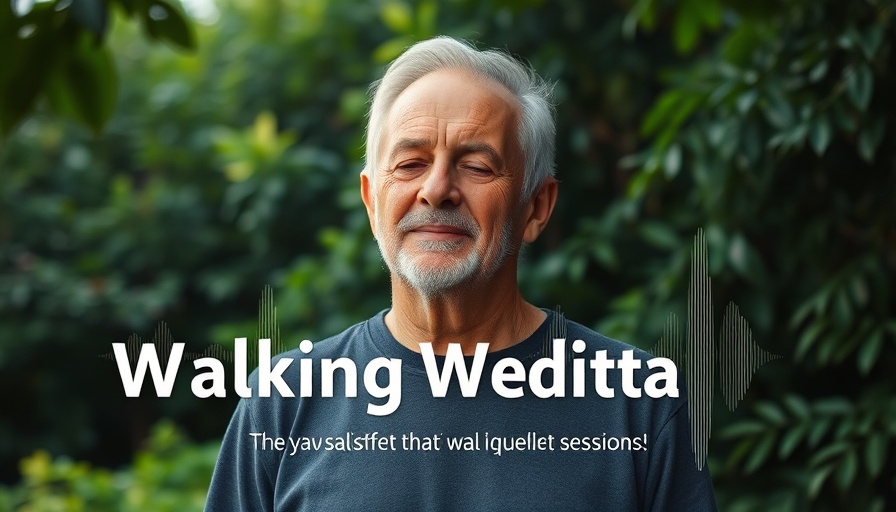
Unlock the Power of Mindful Walking: A Guide to Meditation

0 Views

Discover the Transformative Meditation for Finding Safety in the Body
Update Understanding the Connection Between Mind and Body In today's fast-paced world, many of us find ourselves overwhelmed, battling stress, anxiety, or trauma that can lead us to feel disconnected from our bodies. This emotional disconnect often manifests as physical tension and discomfort, leaving us in a constant fight-or-flight state. Understanding this connection is vital for our overall well-being, particularly as we embark on a journey of healing and self-discovery. Finding Safety Within Emily Jane’s guided meditation offers a grounding practice, acting as a light in our exploration of body awareness. By establishing a sense of safety within, we can train our minds and bodies to reconnect with what it feels like to reside comfortably in our own skin. It begins with something as simple yet profound as breath. Deep, conscious breaths send signals of safety to our nervous systems, allowing us to soften our physical and emotional states. By focusing on our breath, we ground ourselves in the present moment, creating a safe space to explore our feelings. The Role of Body Scanning in Relaxation One of the key elements of this meditation is the body scan technique, which encourages mindful checking in with our physical selves. This practice helps recognize areas of tension and discomfort without judgment or the need for immediate resolution. Instead, by acknowledging these feelings and breathing into them, we promote a sense of compassion and understanding for our body's messages. This simple act can help diminish anxiety and restore a sense of inner peace. The Power of Awareness and Acceptance Awareness is a powerful tool in our wellness toolkit. By engaging in practices that foster this awareness, we begin to disentangle ourselves from the narratives of inadequacy or negativity that often accompany physical discomfort. Instead of pushing through pain or discomfort, we lean into it—allowing ourselves to feel, explore, and ultimately accept our physical state. This acceptance can serve as a building block for cultivating a healthy relationship with ourselves. Incorporating Mindfulness into Everyday Life To truly harness the benefits of the meditation discussed, consider integrating mindfulness into daily rituals. Whether it's through short mindful moments during a busy day or in moments of calm, prioritizing these practices can significantly impact mental health. For instance, spending a few minutes focusing on your breath or doing a quick body scan during lunch can help recalibrate your day. Small adjustments in our routines can lead to profound changes over time. Future Trends: The Growing Importance of Mental Health As society continues to acknowledge mental health as a fundamental aspect of well-being, there is a growing availability of wellness resources, including courses and memberships aimed at fostering mindfulness. The future lies in prioritizing mental health and understanding that it's just as important as physical health, paving the way for holistic approaches to living well. Conclusion: Embracing a Journey of Healing As we navigate our paths towards wellness, embracing practices that connect us to our bodies can be transformative. Through mindfulness, we can learn to love and appreciate our physical selves, paving the way for a healthier mental state. I encourage readers of all ages to let this meditation resonate within, exploring the profound safety that comes from being present in one's body. By embracing these principles, we take significant steps toward achieving peace and resilience.

Unlock the Secret to Being Present: Mindful Practices for All Ages
Update Embracing Simplicity in a Fast-Paced WorldIn an era overflowing with distractions and constant demands, the art of being present can slip through our fingers like sand. However, simple yet effective practices can help us reconnect with the moment and foster a sense of peace. As the warm days of summer give way to the golden hues of autumn, a transition begins that mirrors our own internal journeys. Many find themselves caught up in stories of the past or dreams of the future, but the truth is that the most empowering moments occur when we settle into the present.The Power of Wholehearted AttentionOne of the essential ways to cultivate presence is through wholehearted attention. This practice encourages us to engage fully with our surroundings and experiences. Willem Kuyken reminds us that “joy has its roots in wholehearted appreciative attention.” Take a moment to immerse yourself in a favorite memory, or experience the vibrancy of nature surrounding you. This mindful practice doesn’t only enhance our enjoyment; it also nurtures compassion and empathy towards ourselves and others, enriching our emotional landscape.Breathing: Your Anchor in the StormBreath has an extraordinary ability to ground us. When the pressures of life escalate, it's easy to drift into a whirlpool of anxiety. Implementing a simple breathing exercise can act as an anchor, pulling us back to a state of calm. As J.G. Larochette suggests, repeating a calming mantra can serve to align the body and mind. For those who share mindful moments with children, guiding them through breathing encourages a culture of presence that they can carry into the future.Savoring Each ExperienceOur lives are filled with a blend of highs and lows, yet the practice of savoring helps us appreciate the richness that arises from every moment. Techniques such as reflecting on the feelings associated with both joyful and challenging experiences can deepen our capacity for presence, as seen in Barry Boyce's week-long savoring exercise. By inviting ourselves to relish the sensations of now, we pave the way for gratitude to flourish and enhance our overall well-being.Common Misconceptions About MindfulnessMany people associate mindfulness solely with meditation or quiet reflection, but it’s vital to understand that it’s about being fully engaged in the present. This means that mindfulness can manifest in everyday activities, from cooking a meal to walking in a park. By debunking this myth, we can explore a broader spectrum of practices that foster presence.The Emotional Benefit of Being PresentWhen we unlock the ability to reside in the moment, we also unlock emotional resilience. This skill is particularly important during transitions or stressful times, such as going back to school or navigating changes in personal relationships. Embracing the notion of presence allows us to face life’s challenges with a clearer mind and a fuller heart, ultimately leading to improved mental health.Making Mindfulness Part of Daily LifeIncorporating mindful moments into your daily routine doesn’t require monumental shifts. Start with small, intentional pauses throughout your day. Whether it’s sipping a cup of tea or taking a walk, these moments of mindfulness can transform your perception of daily life. Consider how this can foster deeper connections with those around you and a more harmonious lifestyle.Ultimately, the journey to feeling present and staying present is a personal one, yet it's accessible to everyone. By integrating these mindful practices, we not only enhance our lives but also reflect light in the lives of others. As we embrace the fullness of each fleeting moment, we create a world where presence reigns as the ultimate gift.

Unlocking Mindfulness: Discover Formal and Informal Practices for Daily Life
Update Understanding Formal and Informal Mindfulness In today’s fast-paced world, the quest for mental clarity often leads individuals to mindfulness practices. Two prominent ways to cultivate mindfulness are through formal and informal practices. Understanding these approaches can empower you to embed mindfulness more deeply into your daily routine. Defining Formal Mindfulness Formal mindfulness practices are structured meditations that invite you to consciously dedicate time to the art of being present. This can take various forms, such as guided meditations, body scans, or mindfulness walks. In a formal setting, practitioners typically focus on their breathing or sensations in the body, allowing a deeper connection to their present moment. As Christiane Wolf notes, the key is to genuinely immerse yourself in the practice without dividing your attention. To make the most of your formal practice, you might consider integrating short sessions into your routine. For instance, starting with a five-minute breathing meditation can provide you with a quick but effective mental reset. Exploring Informal Mindfulness Informal mindfulness involves bringing that same quality of awareness to everyday activities. Whether it’s brushing your teeth, walking your dog, or even enjoying a meal, informal mindfulness encourages you to engage fully with what you are doing. This practice doesn’t require a set time and allows for seamless integration into your daily life. Imagine sipping a cup of coffee. How often do you really savor each sip? By shifting your attention fully to this single act, you might find more joy in it. Simple moments like this offer an opportunity to practice mindfulness without the need for designated quiet time. Practical Tips to Enhance Mindfulness Incorporating mindfulness into your life can be simple and rewarding. Start with these strategies: Awareness Triggers: Choose daily tasks to anchor your mindfulness practice. For instance, when you hear a doorbell, take a moment to breathe and appreciate the surrounding sounds. Gratitude Practice: At the end of each day, reflect on three things you appreciated. This practice not only cultivates mindfulness but also helps shift your focus from stress to positivity. The Significance of Mindfulness in Everyday Life Adopting mindfulness can have transformative effects on mental health and overall well-being. Studies have shown that incorporating mindfulness practices can lead to reduced stress levels and improved emotional regulation. By engaging in both formal and informal mindfulness, you create a balanced approach that nurtures mental clarity and emotional resilience. As modern life becomes increasingly complex, ensuring you have these tools at your disposal can be invaluable. Why Mindfulness Matters Mindfulness isn’t merely a trend; it’s a valuable skill set that can improve quality of life. Especially in challenging situations, having the ability to ground yourself in the present can provide invaluable relief. Whether you are worried about a looming deadline or trying to navigate the challenges of everyday life, mindfulness can offer a sanctuary. Engaging with Community Resources Consider exploring local classes or workshops focusing on mindfulness practices. Many community centers, gyms, or yoga studios offer sessions that dive deeper into both formal and informal strategies. Engaging with a community can enhance your understanding and commitment to these practices, creating a support system to share insights and progress with like-minded individuals. A Mindful Future As you delve deeper into mindfulness, consider how it resonates with your life goals and daily challenges. Mindfulness is not just a solitary practice; it can foster a connection with others as you share experiences and insights with friends or discuss practices in social circles. Building a thoughtful, aware community can help further sustain your practice. Take the Next Step To truly embrace mindfulness in your life, consider starting today. Set aside a few minutes to engage in a formal mindfulness practice, or choose to be present during an ordinary task. By taking that first step, you unlock a path that promotes mental clarity and increased enjoyment in your daily life. Explore more resources and join a community focused on mindfulness and well-being. The journey is worthwhile, and you’ll be amazed at the small changes that can lead to significant transformations.
 Add Row
Add Row  Add
Add 

Write A Comment